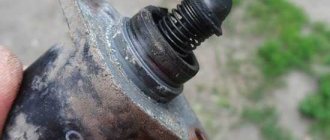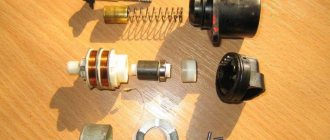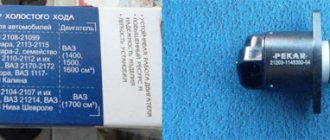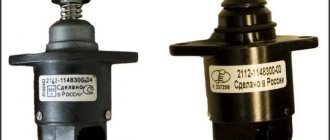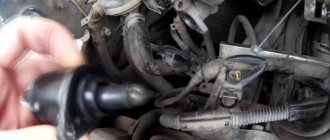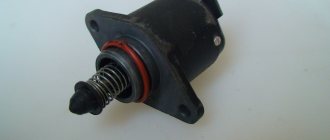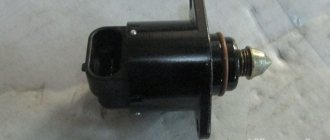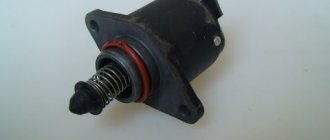The car engine is switched to idle mode (idle speed) by command from the electronic control unit (ECU). This happens at the time of start-up or when it is necessary to warm up the engine. The engine is in this state when the transmission is turned off, when the car is stopped, for example, at a traffic light. The engine operation is controlled by a special idle speed sensor (IAC). Usually it does not cause any special problems, but its breakdown can cause a lot of trouble for drivers. That is why the performance of the DCS must be constantly monitored and, if defects appear, they must be promptly eliminated.
Design
Any DXH provides air flow inside the engine when the throttle valve is closed. Moreover, if previously the idle speed sensor of the carburetor VAZ 2109 functioned as a shut-off valve, the calibrated hole of which could only be either open or closed, then the new idle speed sensor VAZ 2109 injector is capable of independently, depending on the position of the throttle valve, reducing or increasing the amount air, which is needed at different periods of time. That is why experts consider the new version of the IAC not to be a sensor, but a measuring device, and recently it has received the name idle air controller (hereinafter referred to as IAC).
The idle speed control of the VAZ 2109 injector is structurally reminiscent of a miniature module; in addition to the stepper motor, its body contains a rod with a needle with a cone-shaped tip.
The IAC is secured to the throttle body housing with two screws.
The device is also equipped with a 4-pin connector designed to connect the device to the car's ECU.
Knock sensor
Very often, the knock sensor of VAZ 21099 and 210115 fails, thereby disrupting engine operation. After all, its main task is to determine the moment of fuel microexplosions.
Any motorist knows that good proper operation of the engine depends on optimally selected ignition timing angles; ideally, they are different for each engine operating mode. This is why there is an ECU, whose main task is to set these angles as ideally as possible using a knock sensor. It is he who can accurately determine that the ignition timing is set incorrectly. The ECU program is written to set the ignition timing as large as possible in order to prevent the engine from going into the detonation zone.
The VAZ 21099 knock sensor, the injector of which has not been cleaned and diagnosed for a long time, fails very quickly, especially if it is a semi-handicraft fake, of which there are more than 80% on the market. After all, it is equipped with a very sensitive element that works on the principle of the piezoelectric effect. This device is mounted directly on the cylinder block.
If the knock sensor of a VAZ 21099, 210115 or other car brands fails, then the engine begins to overuse fuel, overheat and stall, it loses traction and the timing belt wears out greatly. The VAZ 21099 knock sensor is considered broken, the injector of which begins to produce the following tricks:
- the motor is troublesome;
- the car loses dynamics;
- when starting from a standstill and on an ascent, the check engine of the on-board computer lights up;
- The check engine lights up when the car accelerates quickly.
Principle of operation
The basic principle of operation of the IAC is reduced to changing the cross-sectional area of the calibrated hole in the bypass channel based on the current position of the throttle valve. This change begins with the translational movement of a needle connected to the armature of a stepper motor through a worm gear. Completely closing the bypass channel with the throttle valve fully open does not affect the operation of the power unit. When the needle moves back, the amount of air increases in proportion to the closing angle of the throttle valve. Due to this, it is possible to smoothly regulate the crankshaft speed during the transition from the operating state of the car engine to the idle mode.
Where to begin
You should start setting up the Solex 21083 carburetor by adjusting the fuel level in the float chamber. This involves directly starting the engine and warming it up for five minutes. Then the motor is turned off and the following steps are performed:
The fuel supply hose is carefully separated to prevent gasoline from entering the chamber during further operation. The five screws securing the cover are removed. The choke system cable is removed. The lid is lifted horizontally with extreme caution so that the floats are not damaged. In the chamber itself, the fuel level is measured using a ruler or caliper.
The distance from the top level of gasoline to the edge of the sealing surface of the lid should be from twenty-three to twenty-five millimeters. It is necessary to select an average value, since the fuel level is not able to be in a constant state due to the manifold, which itself does not have the ability to be in a horizontal position all the time. If there is a deviation from the norm in the parameters set earlier, then it is enough to bend the float holders to correct the situation.
Some gasoline is then removed and the reverse carburetor assembly process begins. The key word here is reverse, which means performing the same process, but starting from the end.
If the parameters are within the permitted standards, then the adjustment of the Solex carburetor ends here. Then the transition to the next stage occurs.
IAC connection diagram and its operation
The IAC is connected to the ECU control controller with a 4-wire harness through a standard connector.
The existing electrical circuit does not allow the driver to influence the operation of the IAC, since the control algorithm of the controller is reflashed exclusively on special equipment.
The IAC mechanism works according to the algorithm indicated below:
- When you turn the ignition key, the regulator rod moves to its extreme position and the calibration hole of the air pumping channel in the throttle pipe is completely closed.
- The IAC returns the valve to the primary position after starting to read steps. At this location of the rod, the motor starts and its operation begins in the XX mode.
Important! The basic position of the rod is determined by the ECU firmware - for example, it is equal to 50 steps for Bosch firmware, and for January 5.1 firmware it is 120 steps.
- When the gear is engaged, the throttle valve is open and the IAC does not take part in the operation of the engine - the valve position is closed, while the rod and needle are motionless.
- If the power unit enters idle mode (which means the throttle valve is closed), voltage is transmitted to the stepper motor.
- The needle opens the hole in the valve slightly after the stem begins to move.
- In a roundabout way, the required amount of air moves into the engine (through the slightly open hole of the additional pumping channel), preventing the latter from stalling.
The disadvantage of the VAZ 2109 injector idle speed sensor and its connection to the ECU is the lack of a self-diagnosis system. In case of malfunctions and errors in operation, the driver will not receive any useful information about this. The Check Engine light on the dashboard will not illuminate. Therefore, the driver must independently guess about the malfunction of the regulator based on his own analysis of randomly appearing indirect signs that affect the operation of the engine.
Lada 2109 › Logbook › Unreliable XX system on the VAZ 2109 carb!
The long torment is over and it looks like I have solved the problem! I used to have difficulty idling my car. then the wire flew off, then the solenoid valve did not work, and then the EPHH unit itself flew off. I decided not to bother and, as they say in the language of garage “bugs,” drown it out. Work order: 1) Remove the pan (carburetor cover). You need to remove both covers 2) Next, we unscrew the electromagnetic valve with a peck at 13 (you can see it; there’s just a wire going to it) 3) We take out the yellow jet and see a plastic needle on the valve, carefully cut it off with pliers to the very root. put the jet in place
tighten the valve by hand 4) start the car by sound, tighten it a bit with the key (it’s important not to overtighten it, otherwise I broke the thread and bought a new carb cap) 5) assemble the pan and don’t forget to put in the air filter Consequences: The car will consume more gasoline But not by a lot, since gasoline will always be present in the idle jet. But I think it’s better to turn it off and forget about the problem than to constantly stall without suction) Thank you for watching! I'm waiting for comments!
Like 4 Subscribe
Signs of IAC malfunction and ways to eliminate them
If the engine begins to malfunction or previously unidentified symptoms are observed in its operation, then they may indicate malfunctions in the regulator, for example:
- idle speed is unstable;
- when changing gears or by itself, the engine begins to stall;
- there is no increase in speed when starting the car, which is typical for the primary mode
- warming up;
- When various additional equipment is turned on, the speed decreases.
Similar symptoms are also observed if:
- the bypass channel of the throttle assembly is clogged with dirt;
- there is damage to electrical wires (breaks, broken contact connections, etc.);
- The installed IAC variant does not match the ECU firmware type.
Before starting diagnostics of the regulator, it is recommended to make sure that the above defects are absent.
How to choose jets?
The selection of jets for Solex 21083 is made taking into account the engine size. Experts recommend starting the selection with a fuel nozzle for the first chamber. Having selected the desired sample, we select the corresponding air analogue for it. And then in the same order we select the jets for the second chamber. First you need to look for a factory carburetor designed for the size of your engine, remove the jets from it and take them as a reference point. Further selection of jets is made according to this principle. If you need to lean the mixture a little, choose a larger jet by one pitch. If you want to enrich it, use a smaller jet.
Emulsion hoses are assembled along with the jets. These tubes are designed to adjust the composition of the fuel mixture in accordance with engine speed. There are three types of tubes: 23, ZC and ZD. The first are used for Solex 21083 carburetors installed on transverse chisel engines. For the first chamber of carburetors of UZAM power units, ZD tubes are used, and for the second - ZC.
Dismantling the IAC
Dismantle the regulator as follows:
- Block the car with a handbrake or wheel chocks.
- Remove the terminals from the battery.
- Disconnect the connecting connector from the IAC.
- Clean the area around the IAC from contamination.
- Unscrew the 2 mounting screws.
Having completed all these operations, the regulator is removed from the mounting socket.
Checking the serviceability and restoring the functionality of the IAC
Check the functionality of the regulator as follows:
- Connect the battery to the vehicle's on-board network and, holding the IAC in your hands, put the power supply block in place.
- Turn on the ignition. In this case, the regulator rod should retract inward and then extend back to a certain distance. If the IAC acts this way, then it is operational. Otherwise, it must be replaced.
Sometimes the functionality of the regulator is restored after cleaning the spring, valve hole and needle.
Clean the IAC with a cleaner like WD-40. In this case, there is no need to disassemble the device - just treat the rod, needle and spring with a solvent. It also doesn’t hurt to spray the cleaner inside the XX channel, which will clear the valve hole of any contaminants. As soon as the cleaner dries, the functionality of the regulator is checked again and only after that a decision is made on the advisability of replacing it.
IMPORTANT! Before installing a newly purchased or repaired IAC, it is recommended:
Make sure the product matches the vehicle ECU firmware; check functionality; Lubricate the spring and rod with grease.
When choosing an IAC VAZ2109 injector, avoid purchasing counterfeit products. A fake is distinguished by the following characteristics:
- information on the packaging does not allow identifying the manufacturer;
- yellow color of the sticker on the product body;
- dark tip of the locking needle;
- thin sealing ring.
The figure below will help you distinguish the old-style sensor (on the right) from the new-style sensor (on the left):
Replacement process
Don't know how to replace the device? — To carry out the procedure you will need a set of tools.
To carry out the replacement, it is necessary to remove the distributor from the additional equipment unit:
- First you need to disconnect the negative terminal from the battery;
- Next, you should disconnect the armored wire from the distributor, and also disconnect the hose from the vacuum corrector;
- then you need to remove the gas cable and put it aside;
- Having unscrewed the fastening nut of the bracket holding the wires, it must be removed from the stud and moved away so that it does not interfere;
- then put a mark in the form of a straight line on the drive housing of the auxiliary units and the distributor, so that when reinstalling, set the previous ignition timing;
- Next, you need to disconnect the block with wires;
- Having removed the plug from the hole in the clutch housing, use a screwdriver to turn the flywheel so that the piston of the first cylinder reaches the TDC position;
- Now, having unscrewed the two fastening nuts, you can dismantle the distributor.
The process of replacing the Hall sensor on a VAZ consists of the following steps:
- First you need to unscrew the distributor cap.
- Then, remove the slider by pulling it up a little.
- Next, you need to remove the dust cover.
- After unscrewing the mounting bolt, you need to remove the plug.
- Next, unscrew the bolts holding the sensor plate.
- After unscrewing the mounting bolts of the vacuum corrector and removing the locking ring, you need to dismantle the corrector and the rod.
- Unclamp the clamp and remove the wires.
Unclench the clamp and take out the wires
After replacing the device, you should check the operation of the VAZ 2109 carburetor.
